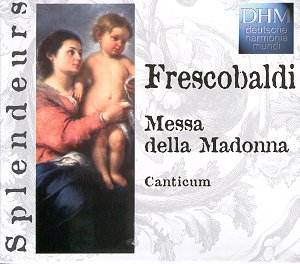Frescobaldi
continues to be one of those composers more honoured in the
history books than in the concert hall. Although his output
was considerable, and published in many collections even in
his own lifetime, covering all the current forms of vocal and
instrumental writing, it is his keyboard music for which he
is now remembered.
Working
in Rome at a time just after the Council of Trent had had a significant impact
on the music life of the Catholic Church, Frescobaldi was adept
at combining the latest compositional techniques and devices
of keyboard writing with the more traditional liturgical structures
of the alternatum setting of the Mass. This had
descended from alternating verses of ancient plainsong, sung
by one side of the choir, then the other. By the early 17th
century the idea of alternating the plainsong liturgy and music
performed either on the organ or by an instrumental ensemble
was commonplace.
This
disc juxtaposes excerpts from Frescobaldi’s 1635 Fiori Musicali
with the appropriate liturgical plainsong of the Mass for the
Feast of the Blessed Virgin Mary, one of three such alternatum
mass settings in the collection.
This
music is the mature Frescobaldi, sure in the handling of complex
imitative writing and filled with piquant harmonic touches.
These latter are all the more apparent on this recording as
the organ - one of few surviving instruments by the famous Italian
Renaissance Antegnati family of organ builders - is tuned in
an unequal temperament of pure major thirds which gives some
keys and chords a very robust “rural” character; what the uninitiated
call “out of tune”. Indeed, the whole sound-world of such organs
is unusual to modern ears, but nonetheless effective in this
repertoire.
Although
small by northern European standards, consisting of only thirteen
stops of all metal pipes with a non-independent pedal, permanently
coupled, of fourteen notes, this organ furnishes a range of
colour and sweetness that is more than enough for the music.
Two tracks in the Mass stand out in particular. The Toccata
Sesta per l’organo sopra i pedali with which the mass ends
is a substantial work, over five minutes long, and clearly showing
how Bach was influenced by Italian writing in his florid writing
for manuals. Bach acquired a copy of the Fiori Musicali,
in Weimar in 1613, the collection having been introduced northern
lands by Frescobaldi’s pupil Froberger. Similar large-scale
effects are audible in the Recercar con obligo di cantare
la Quinta parte senza torccarla) in which the organ and
the plainsong - in this case a 17th century modernisation
of the Sancta Maria, ora pro nobis chant that Monteverdi
also used in similar way in the Sonata sopra Sancta Maria
in his 1610 Vespers - are combined rather than alternating verse
and verse about. The alternatum structure having been predominant
throughout the disc up to this point the effect of this combination
of timbres is considerable.
The
singers are the eight-strong German plainsong group Canticum.
Their performances are admirable, although one does find that
the polish and perfection of intonation is rather lacking in
character given that this is supposed to be liturgical music
from the hot Mediterranean lands. That aspect is even more notable
in comparison to the rougher edges of the organ’s unequal temperament
tuning. It is also somewhat disappointing that the unaccompanied
plainsong sections were recorded separately in a church in Mandelsloh,
rather than in the monastery church where the organ is located.
This is not necessarily audible on the disc, but the fact is
still a bit disappointing. There are also times, not so much
in the Mass, but more apparent in the Vespers that form the
second half of the disc, where there is a distinct forcing of
the sound that gets uncomfortable on the ear. An example is
in the quite high-lying chant of the psalm 112 and its antiphon
Jam hiems in track 16 or the peaked phrases of the Ave
Maris Stella hymn. A more fluid approach, using fewer singers
and less close mic placement would have been beneficial.
While
one has to have some reservations about the consistency and
imaginativeness of the chanting, there are few qualms about
the organ playing of Lorenzo Ghielmi. As pointed out earlier,
the strongly unequal temperament of the organ’s tuning is probably
going to be off-putting to many listeners, especially given
the frequency of chromatic passages in Frescobaldi’s music,
but Ghielmi’s command of early Italian baroque rhetoric shines
through in all his playing. Amongst other things, he was co-founder
of the ensemble Il Giardino Armonico, which has become
well known for cultivating a flamboyant style of performance
of Italian music. This same effect is frequently heard in the
playing here, especially in the toccatas and is undeniably enjoyable.
That having been said, the combination of plainsong, pure tuning
and fairly dense organ writing is probably going to make this
disc more one for the Frescobaldi devotee than the punter after
some big organ noise.
Peter
Wells

![]() Canticum/Christoph Erkens
Canticum/Christoph Erkens![]() DEUTSCHE HARMONIA MUNDI 74321 935472 [68.13]
DEUTSCHE HARMONIA MUNDI 74321 935472 [68.13]





